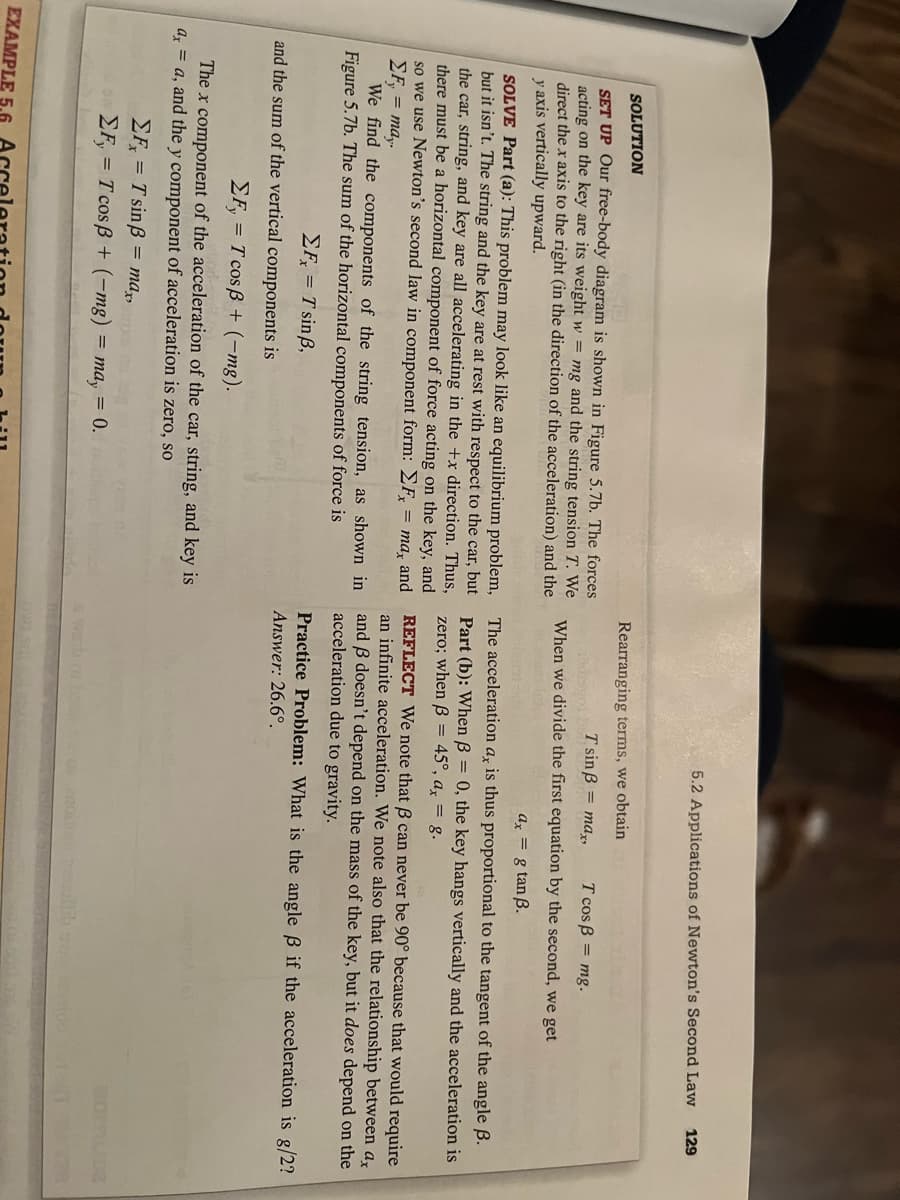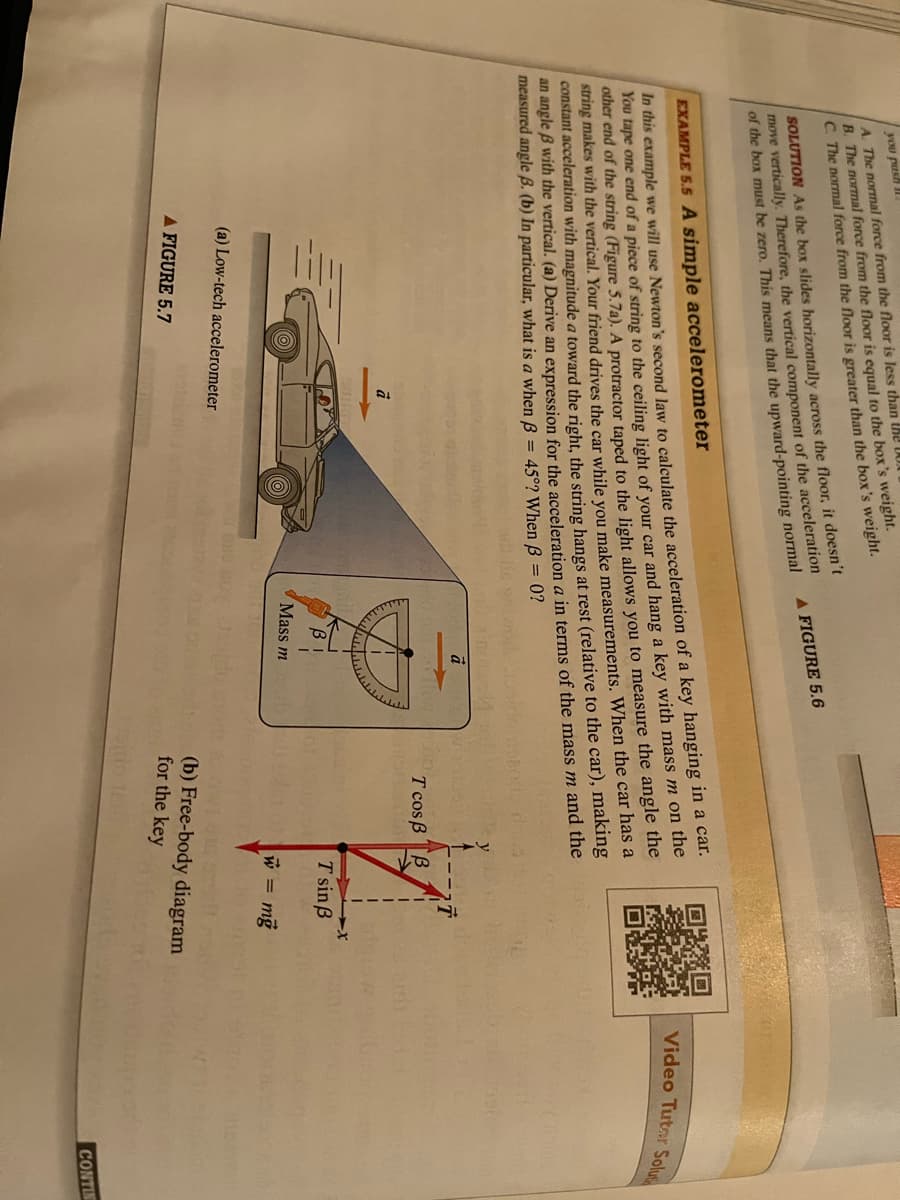Practice Problem: What is the angle ß if the acceleration is g/2? Answer: 26.6°.
Practice Problem: What is the angle ß if the acceleration is g/2? Answer: 26.6°.
Related questions
Question
100%
What is the angle B if the acceleration is g/2?
Answer 26.6 degrees

Transcribed Image Text:SOLUTION
SET UP Our free-body diagram is shown in Figure 5.7b. The forces
acting on the key are its weight w = mg and the string tension T. We
direct the x axis to the right (in the direction of the acceleration) and the
y axis vertically upward.
SOLVE Part (a): This problem may look like an equilibrium problem,
but it isn't. The string and the key are at rest with respect to the car, but
the car, string, and key are all accelerating in the +x direction. Thus,
there must be a horizontal component of force acting on the key, and
so we use Newton's second law in component form: Fx = max and
ΣF, = may.
We find the components of the string tension, as shown in
Figure 5.7b. The sum of the horizontal components of force is
ΣF = T sinß,
and the sum of the vertical components is
ΣΕ, = T cosB + (-mg).
The x component of the acceleration of the car, string, and key is
ax = a, and the y component of acceleration is zero, so
EXAMPLE
EF=Tsinß= max,
EF, = T cosß+ (-mg) = may = 0.
5.2 Applications of Newton's Second Law
Rearranging terms, we obtain
T sinB = max
129
T cos ß = mg.
When we divide the first equation by the second, we get
arom indur
ax = g tan B.
The acceleration ax is thus proportional to the tangent of the angle B.
Part (b): When ß = 0, the key hangs vertically and the acceleration is
zero; when ß = 45°, ax = g.
REFLECT We note that ß can never be 90° because that would require
an infinite acceleration. We note also that the relationship between ax
and 3 doesn't depend on the mass of the key, but it does depend on the
acceleration due to gravity.
Practice Problem: What is the angle ß if the acceleration is g/2?
Answer: 26.6°.

Transcribed Image Text:you push
A. The normal force from the floor is less than the U
B. The normal force from the floor is equal to the box's weight.
C. The normal force from the floor is greater than the box's weight.
SOLUTION As the box slides horizontally across the floor, it doesn't
move vertically. Therefore, the vertical component of the acceleration
of the box must be zero. This means that the upward-pointing normal
EXAMPLE 5.5 A simple accelerometer
In this example we will use Newton's second law to calculate the acceleration of a key hanging in a car.
You tape one end of a piece of string to the ceiling light of your car and hang a key with mass m on the
other end of the string (Figure 5.7a). A protractor taped to the light allows you to measure the angle the
string makes with the vertical. Your friend drives the car while you make measurements. When the car has a
constant acceleration with magnitude a toward the right, the string hangs at rest (relative to the car), making
an angle B with the vertical. (a) Derive an expression for the acceleration a in terms of the mass m and the
measured angle B. (b) In particular, what is a when ß = 45°? When ß = 0?
à
(a) Low-tech accelerometer
A FIGURE 5.7
A FIGURE 5.6
à
BI
Mass m
T cos BB
05290
T sin B
W = mg
(b) Free-body diagram
for the key
Video Tutor Solus
CONTIN
Expert Solution
This question has been solved!
Explore an expertly crafted, step-by-step solution for a thorough understanding of key concepts.
This is a popular solution!
Trending now
This is a popular solution!
Step by step
Solved in 2 steps with 2 images
